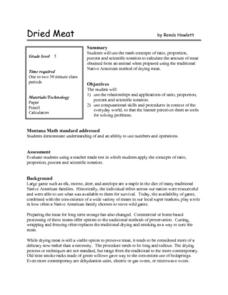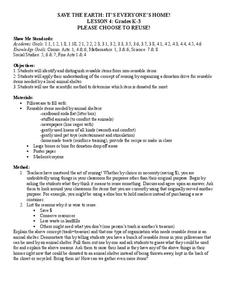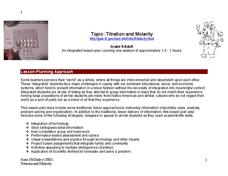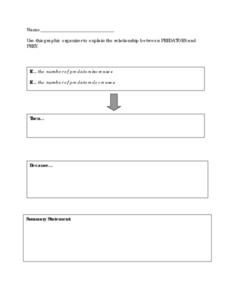Curated OER
Animal Rights Vs. Animal Welfare - Understanding the Issue
Students explore the difference between animal rights and animal welfare. They take a field trip to a farm to explore the producing animals for human use. After researching and collecting information from animal welfare/rights...
Baylor College
Plant or Animal?
Teach your class about the necessities of life using the book Tillena Lou's Day in the Sun. After a teacher-read-aloud, students make puppets depicting different plants and animals from the story and illustrating the habitat in which...
Baylor College
Animals' Needs
Explore the wonderful world of earthworms as your class learns about the requirements of animal life. After building soda bottle terrariums, students observe worms over the course of a couple weeks, building an understanding that all...
Baylor College
Needs of Living Things: Post-Assessment
Assess your class's knowledge of the needs of living things with the final lesson in a series. Given a large piece of paper and coloring utensils, young scientists draw a picture of themselves and a plant or animal of their choosing,...
Alabama Wildlife Federation
Life in a Pond
What living things call an aquatic habitat home? Young learners consider the question after they discuss the characteristics of a typical pond habitat. They identify an animal and then determine if a pond would have all the components to...
Cheetah Outreach
Habitats
Explore six different habitats—wetlands, rainforest, savannah, desert, city, and cultivated land—to determine which habitat factors (food, water, shelter, and space) are high, medium, or low in each. Learners also use maps of Africa to...
Curated OER
Mealworms
Crawl into the world of the darkling beetle with this scientific investigation. Watch as the insects move through the larval, pupal, and adult stages of life, recording observations along the way. Discuss the necessities of life as young...
Curated OER
Oceans in Motion
This simple lesson introduces children to basic marine life as well as to show them the necessity of protecting aquatic environments. Some famous marine life animals are introduced via vocabulary words, then children cut out pictures of...
Michigan Sea Grant
Fish Habitat and Humans
Strict habitat requirements are needed for the survival of fish populations and fish variety in the Great Lakes. Young scientists become experts in the basic needs of fish and understand how survival necessities can vary with different...
Curated OER
Garden of Eden
Learners view a video clip about animals and their habitats. They work together to discuss how different animals adapt to their environments. They create a new habitat for a specific animal and draw new adaptations for them.
Curated OER
How Many Birds Would It Take To Keep A Jackal Alive?
Middle schoolers examine the role of large families in some animal populations. They work together to complete an activity related to food supply. They discover the relationship between preys and predators.
Curated OER
Dried Meat
Students investigate the traditional method of drying meat used by Native Americans. They apply math concepts such as ratio, proportion, percent, and scientific notation to determine the amount of meat the is dried from an animal using...
Curated OER
Shelter
Students study shelter and how plants, animals, and people must have shelter to survive. For this shelter lesson, students read paragraphs about various shelters and their necessity with plants, animals, and people.
Curated OER
A Duck Needs
In this animal education worksheet, students fill in 10 circles with what a duck needs. There is a duck at the top of the page and circles at the bottom.
Curated OER
Save the Earth: It's Everyone's Home!
Students organize a donation drive based on the concept of reusing items for an animal shelter. In this reusing items lesson plan, students distinguish between reusable and non reusable items, have a donation drive, and use the...
Curated OER
Needs and Wants
Students examine the difference between needs and wants. In this consumption lesson, students illustrate their needs and wants and discuss their own reasons for buying things. They also discuss the connection between their choices and...
Curated OER
Learning About Animals' Bodies
Pupils research different animals (mammals, reptiles, amphibians, insects, birds, fish) and create books, murals, dioramas, puppets, and sculptures to illustrate the necessity of various body parts for overall survival. In this animal...
PBS
Home, Sweet, Home!
Students investigate the local history and architecture of their community. They draw maps, conduct Internet research, discuss varied architectural designs, take a walking tour of their town and work in teams to record their community's...
Curated OER
Archeology: Weapons of the Texanos
Students develop archaeological context skills through a simulation which places them in the year 2500. After listening to the teacher read, "Weapons of the Texanos," they record what they think the weapon is. Next, in groups, they...
Curated OER
Titration and Molarity
Students are introduced to the concepts of molarity and titration. As a class, they develop a list of the correct steps they need to follow to create a specific concentration of a solution. They design and complete an experiment in...
Curated OER
How Atoms Work
High schoolers analyze the way atoms function and how they combine to form molecules and various compounds. Using a software program, they create a diagram of an atom and write a summary about their functions. They complete a worksheet...
Curated OER
How Atoms Work
Students explore the concept of atoms and how they combine to form molecules and compounds. In pairs, they read an article on how atoms work and discuss the main points. They draw atoms and write a paragraph about their elements.
Curated OER
Titration and Molarity
Students investigate the concept of molarity and its relationship to the concentration of a solution. After mixing chemical solutions, they calculate how many moles of acid and base should be in each solution. They record their results...
Curated OER
Predators and Prey
Students explain how the food chain works. They contrast predators with prey and describe their function in nature. Students discuss how the food chain aids in keeping nature balanced. In small groups, they play a game that simulates the...

























